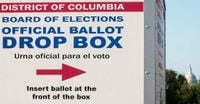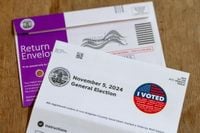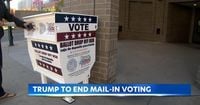President Donald Trump has reignited a fierce debate over the future of mail-in voting in the United States, launching a renewed campaign to abolish the practice ahead of the 2026 midterm elections. The move, announced through a flurry of social media posts and public statements on August 19, 2025, has sparked divisions not only between Republicans and Democrats but also within Trump’s own party, as lawmakers and strategists weigh the potential impact on voter turnout and electoral outcomes.
At the center of the controversy is Trump’s assertion that mail-in voting facilitates widespread fraud and undermines election integrity. In a Truth Social post early Monday morning, the president declared, “We are now the only Country in the World that uses Mail-In Voting. All others gave it up because of the MASSIVE VOTER FRAUD ENCOUNTERED.” He continued, “WE WILL BEGIN THIS EFFORT, WHICH WILL BE STRONGLY OPPOSED BY THE DEMOCRATS BECAUSE THEY CHEAT AT LEVELS NEVER SEEN BEFORE, by signing an EXECUTIVE ORDER to help bring HONESTY to the 2026 Midterm Elections. Remember, the States are merely an ‘agent’ for the Federal Government in counting and tabulating the votes.”
However, these claims have been swiftly challenged by both data and political opponents. According to the International Institute for Democracy and Electoral Assistance, 33 countries, including the United States, permit some form of mail-in balloting. A dozen, such as Canada, Germany, and the United Kingdom, offer it universally to all voters, while another 21—including Australia, France, and Japan—allow it for specific groups. Trump’s assertion that the U.S. is alone in this practice is, therefore, demonstrably false, as reported by Roll Call.
Trump’s attempt to frame mail-in voting as a uniquely American problem is not new. He has railed against the practice since his 2020 defeat to Joe Biden, blaming mail-in ballots for his loss and arguing that they give Democrats an unfair advantage. During a meeting with Ukrainian President Volodymyr Zelensky on August 18, Trump told reporters, “If you have mail-in voting, you’re not going to have many Democrats get elected. That’s bigger than anything having to do with redistricting and the Republicans have to get smart.”
But the Republican Party’s relationship with mail-in voting is more complicated than Trump’s rhetoric suggests. In the 2024 election cycle, Republicans launched “Swamp the Vote USA,” a nationwide get-out-the-vote initiative that aggressively encouraged mail-in voting among GOP supporters. The results were striking: data from the University of Florida’s Election Lab cited by The New York Times showed that the share of registered Republican mail-in voters in Pennsylvania jumped from 24% in 2020 to 33% in 2024. Trump ultimately flipped the state, winning by less than two points after losing it by a similar margin four years earlier.
Florida, another pivotal battleground, saw more than three million mail-in ballots cast in 2024. Trump’s margin of victory in the Sunshine State surged to 13.1 points, up from just over three points in 2020. “It is proven to work to make this push for mail-in voting and restore trust in our election process,” an unnamed GOP operative told The Hill. “I don’t see the point in taking a step back from that.”
Nonetheless, Trump’s latest push for a sweeping ban on mail-in ballots has found allies among some Republican officials. The Republican National Committee issued a statement backing Trump, saying, “President Trump is absolutely right, we need safe and secure elections.” Representative Marjorie Taylor Greene of Georgia echoed the sentiment on X, writing, “Elections have been stolen for decades with this practice that is ripe for fraud. Save America by saving our elections!!!”
Yet, there is clear dissent within the party ranks. Privately, several Republican strategists and operatives have voiced concerns that eliminating mail-in voting could backfire. “It wouldn’t be good for Republicans,” one operative said, pointing to the party’s recent successes with mail-in ballots. “I haven’t talked to anyone who is on board with this.” The operative added, “I do think President Trump says a lot of things, some really great things, and sometimes it’s in a way where he’s gauging to see where people stand on it. I don’t see a lot of Republicans getting on board with this.”
There’s also confusion about what exactly Trump is targeting. Florida Governor Ron DeSantis, when asked about the proposal, suggested Trump’s comments referred to states with universal mail-in voting, such as California and Nevada, where ballots are automatically sent to all voters. “What he means by vote by mail, I think, just in my conversations, is the states like California and Nevada and others, where they just send all these ballots out into the ether,” DeSantis said. “I think what Florida has is absentee voting.” In Florida, voters must request a mail-in ballot, a process DeSantis argues is more secure.
Trump’s campaign against mail-in voting is not limited to rhetoric. In March 2025, he signed an executive order requiring proof of citizenship for voter registration and directing the attorney general to challenge states that count absentee or mail-in ballots received after Election Day. However, a federal judge blocked parts of the order in June, arguing that the president lacked authority to override state election rules. This setback prompted a shift in the administration’s approach. On August 20, White House Press Secretary Karoline Leavitt told reporters that the administration would now seek legislative solutions, working with Congress and state legislatures “to ensure that we’re protecting the integrity of the vote for the American people.”
The White House doubled down on its criticism of Democratic-led states, with Deputy Press Secretary Harrison Fields accusing them of “eroding faith in our elections with reckless laws, such as unfettered mail-in voting, illegally changing laws to benefit their voters, and slow-walking the counting of votes far past Election Day.” Fields reiterated Trump’s 2024 campaign platform: “President Trump wants to secure America’s elections and protect the vote, restoring the integrity of our elections by requiring voter ID, ensuring no illegal ballots are cast, and preventing cheating through lax and incompetent voting laws in states like California and New York.”
Democratic leaders, meanwhile, have condemned Trump’s efforts as a thinly veiled attempt at voter suppression. Senator Alex Padilla of California accused Trump of taking cues from authoritarian leaders, stating, “Trump knows the MAGA agenda is unpopular: raising your grocery prices and hiking up your health care premiums, all while handing out tax breaks to billionaires. So he’s resorting to desperate schemes to cling to power.” Padilla added, “Even his preferred news outlets, Newsmax and Fox News, have been forced to answer for pushing conspiracies about voting machines. They admitted what Trump won’t — he lost the 2020 election, and mail-in voting is secure.”
The numbers tell a nuanced story. According to the U.S. Election Assistance Commission, mail-in voting accounted for 30.3% of turnout in 2024, down from 43% in 2020 but still above pre-pandemic levels. Data analyzed by TargetSmart for NBC News showed that of the 65.7 million mail ballots requested in 2024, 44% were from Democrats, 29% from Republicans, and 27% from voters registered with other parties. Former Texas State Representative Matt Rinaldi, a vocal supporter of restricting mail-in voting, argued that “Democrats have admitted that mail-in balloting is the number one conduit for fraud in elections,” though no widespread evidence supports this claim. Rinaldi suggested a state-level approach: “When I was chair of the Republican Party in Texas, our priority was one-day, in-person balloting only. Mail-in voting only upon need.”
As the debate rages, the future of mail-in voting in America hangs in the balance. With both sides digging in and legal, legislative, and political battles looming, the issue is sure to remain at the forefront of national attention as the 2026 midterms approach.






